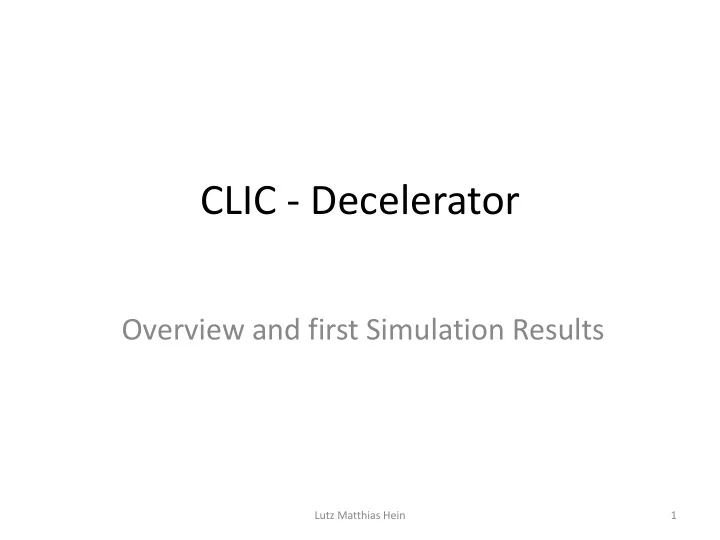

CLIC - Decelerator Overview and first Simulation Results Lutz Matthias Hein 1
General Overview 12 GHz RF-System Lutz Matthias Hein 2
Why 12 GHz? CLIC Electric Field [MV/m] 100..120 MV/m 12 GHz Tesla Cavities 50..60 MV/m (supercond.) 1[..]3 GHz ~ 35MV/m Frequency [MHz] Lutz Matthias Hein 3
Why 4 Beams? CLIC 100..120 MV/m Tesla Cavities 50..60 MV/m (supercond.) • Normal Conducting Material - Copper Lutz Matthias Hein 4
12 GHz – Drive Beam Drive Beam Linac RF 1 GHz with 0.5 GHz Bunch Structure CR1 DL x3 x2 x24 CR2 x4 12 GHz Bunch Structure 100 × ‘safe beam’ Lutz Matthias Hein 5
Types of Decelerator 6.14GeV 1500GeV Stronger quadrupoles required (830m) (1040m) -> Skip cavities for quadrupoles -> 24 different Decelerator Lattices 6
Important to know !! The Decelerator is used to decelerate the Drive Beam! 1 2 3 N-1 N The head sees an empty cavity meanwhile the rest experiences the beam wake fields. -> Hugh Energy Spread Lutz Matthias Hein 7
Main Objectives Detect and estimate particle losses Investigate the LOSS PATTERNS Find Damage Limits Lutz Matthias Hein 8
Possible Errors • Misinjection • Quadrupole Alignment • Quadrupole Field Errors (assumed to be static during 1 bunch train) • RF-Break-Downs -> Wrong Energy, Dipole Kick ... • ??? Lutz Matthias Hein 9
Possible Errors • Misinjection • Quadrupole Alignment Used to simulate • Quadrupole Field Errors (assumed to be static during 1 bunch train) • RF-Break-Downs -> Wrong Energy, Dipole Kick ... • ??? Lutz Matthias Hein 10
Step 1 Estimate Limits of Single Quadrupole Offsets Decelerator Nr. 11 ( with 876 Quadrupoles) : 1 2 3 875 876 Misalign single Quadrupole: 1 2 3 875 876 !! There are differences between focusing and defocusing Quadrupoles !! (s pq ≈ 20µm ) Lutz Matthias Hein 11
Physics – Wakefields Alignment Error -> Beam Offset F D 2 3 Wakefields in the Beam Pipe Image Charge Beam Pipe Real Beam Image Charge Lutz Matthias Hein 12
Physics – Wakefields Dipole Modes and Beam Break-Up Due to the bunch offset dipole modes of the cavity are excitated, which stimulate the following bunches to enhance these modes. Lutz Matthias Hein 13
Physics – Wakefields Dipole Modes and Beam Break-Up At certain configurations of beam current, cavity quality etc. the dipole modes can ‚kick - out‘ the beam, so call Beam -Break-Up. Lutz Matthias Hein 14
Results of the Energy Spread I) Kick itself Low Energy High Energy F -> Filamentation & II) Chromaticity Emittance Growth Focus F High Energy Low Energy Lutz Matthias Hein 15
G – Space Q(51) 50µm 100µm 200µm X‘ [µrad] 500µm 750µm 1000µm X [µm] Lutz Matthias Hein 16
Most Important Parameter Charge Density: Scraping !! X‘ [µrad] Q I= D x* D y X [µm] Lutz Matthias Hein 17
Characteristic Curves When do we hit the aperture? Xmax [µm] Quadrupole Offset [µm] Lutz Matthias Hein 18
Damage Levels How does the Beam look like? Y Xmax [µm] Quadrupole Offset [µm] X Q Above Damage I = Level ?? D x* D y Map of the max. Beam Kicks as Function of the Damage Level Lutz Matthias Hein 19
Step 2 Estimate Limits of Multiple Quadrupole Offsets Decelerator Nr. 11 ( with 876 Quadrupoles) : 1 2 3 875 876 Misalign of several Quadrupoles: 1 2 3 875 876 When can I simply add qp-kick up? When do the kicks amplify the emittance? Lutz Matthias Hein 20
Drawbacks In the decelerator particle tracking is not possible. Tracking is done with a special beam consisting of macro-particle + S -matrix X j post-processing needed for + Sliced Intensity distribution Beam Particle Losses Damage Evaluation X i Lutz Matthias Hein 21
Pre-/Post-Processing Own Code for Post Processing 3. Energy Deposition 1. Intensity Calculation 2. Loss Detection Y In Progress X Satellite Particles Lutz Matthias Hein 22
Drawbacks Electron Beam: - 2.4 GeV down to 200MeV - 12 GHz Structure -> 1mm .. 6 mm Beam length - 8.4 nC bunch charge ? Space Charge Effects ? Space Charge Effects are not included in the simulation code so far. Try other Programms to estimate space charge effects -> Particle Distribution and Lattice are needed to be converted. Lutz Matthias Hein 23
Drawbacks Use other program to estimate the space charge effects Path Manager Astra + tested and benchmarked + tested and benchmarked for Hadron Linacs for Electron linacs incl. gun + easy to use and free output + “easy“ to use and output data data + Particle tracking + good manual + good manual + Particle tracking - no detailed tests for - Need Field maps for the electron linacs PETS - no wake fields Lutz Matthias Hein 24
Space Charge Results First results: Placet Vs. Path Manager (no Space Charge) Lutz Matthias Hein 25
Space Charge Results First results: Path Manager (Space Charge) Lutz Matthias Hein 26
Outlook • Perform Space Charge Calulations using ASTRA • Get lost patterns for single Quadrupole kicks - check filamentation - damage levels / damage as Fct.(s) • Quadrupole Kicks Step 2 Lutz Matthias Hein 27
Recommend
More recommend